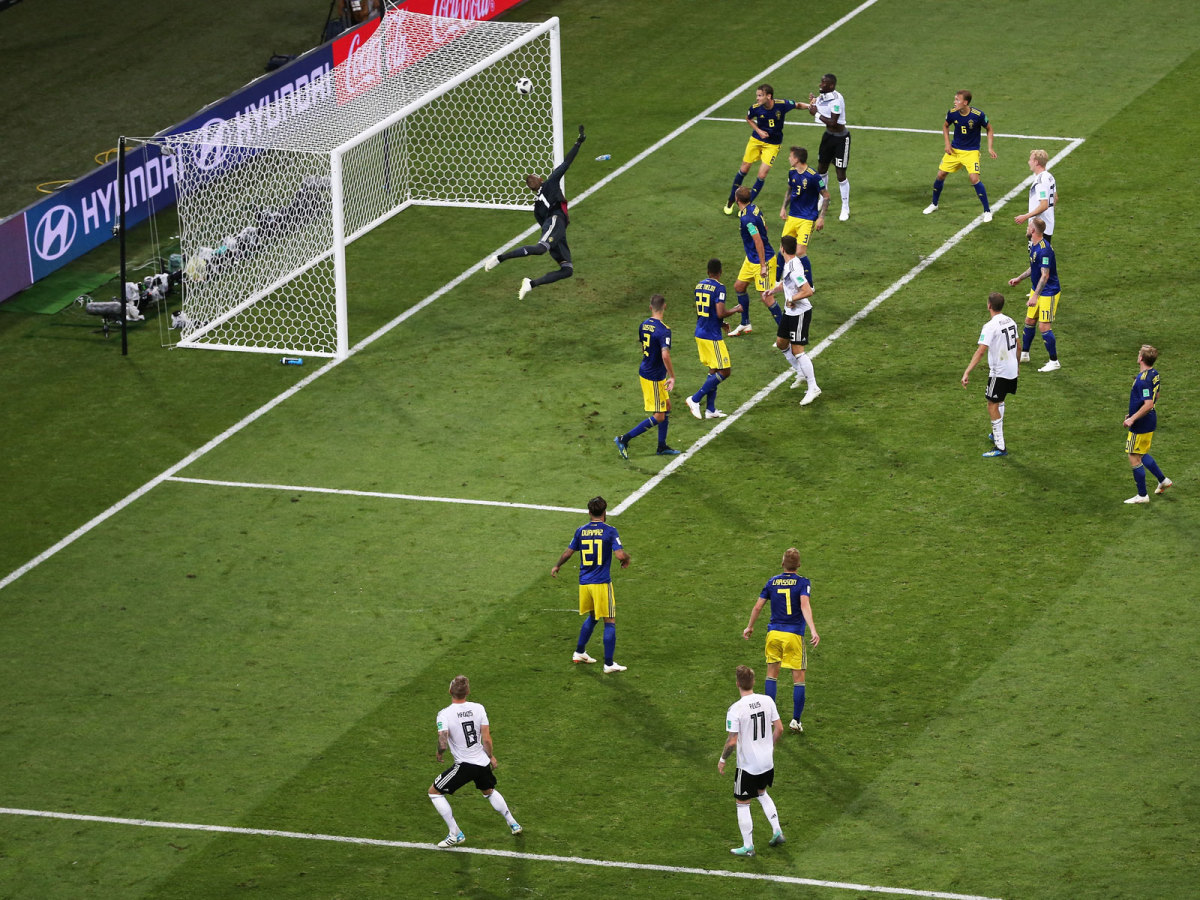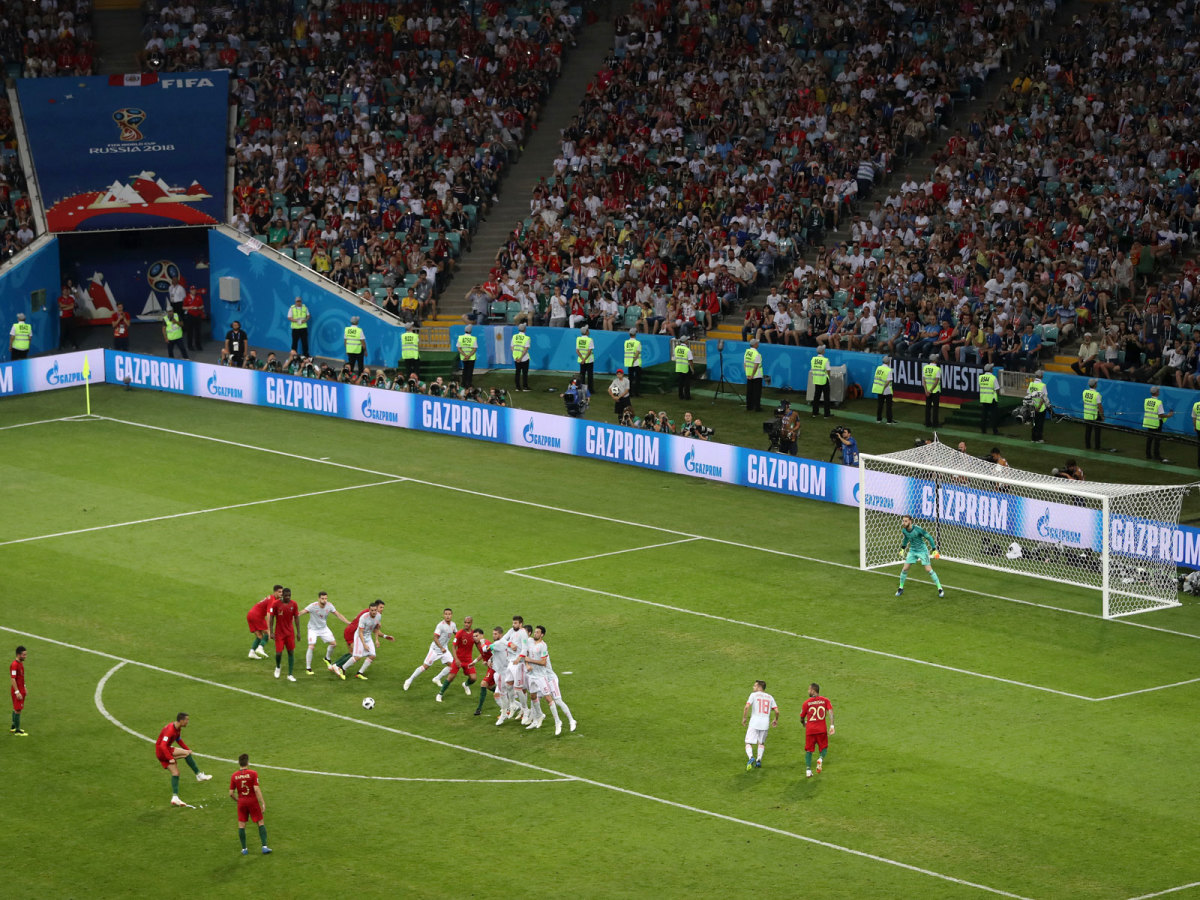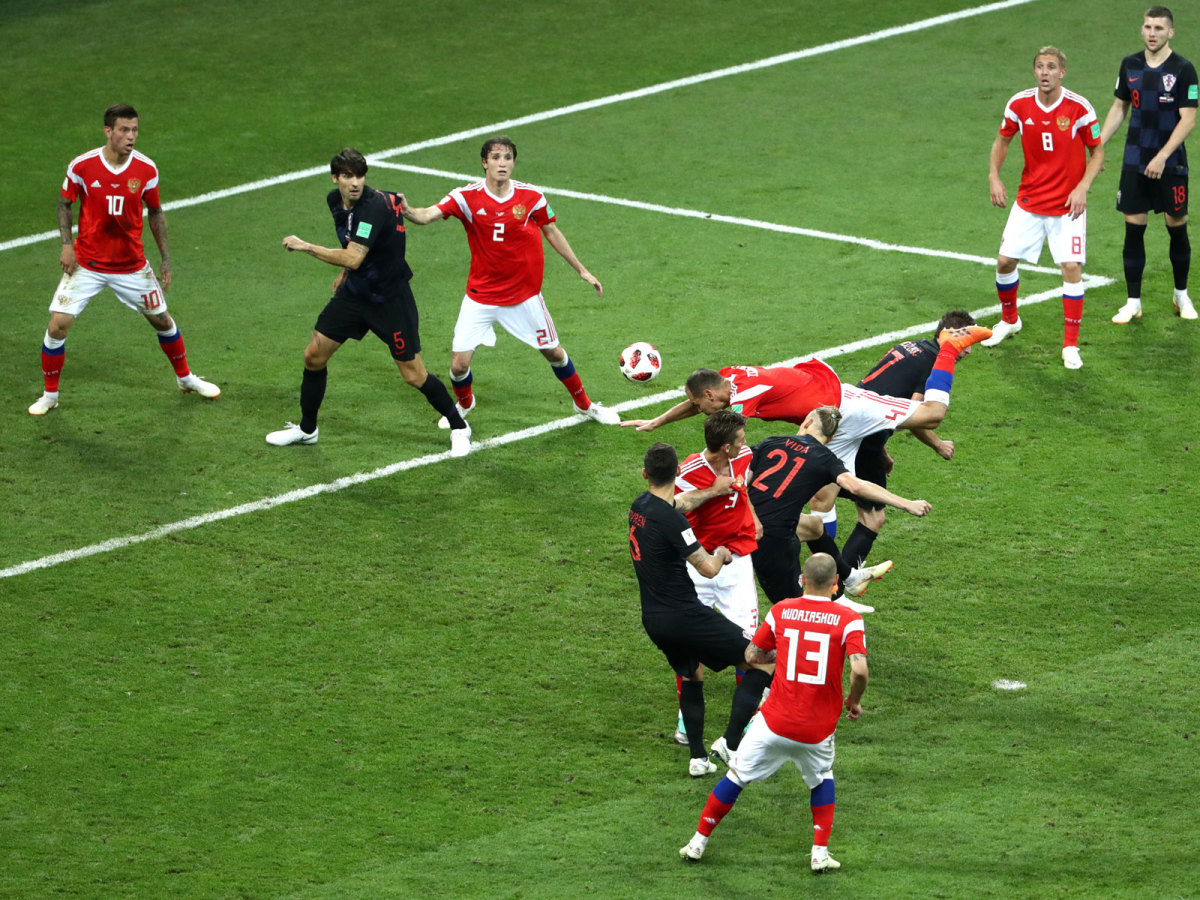The World Cup of Set Pieces: How Teams Are Living Off Dead-Ball Plays

This story appears in the July 16, 2018, issue of Sports Illustrated. For more great storytelling and in-depth analysis, subscribe to the magazine — and get up to 94 percent off the cover price. Click here for more.
***
In a World Cup that has been defined by surprises and delightful attacks, it was one of the most creative moments of the tournament. And it started from a standstill.
During a group-stage victory over Panama, England won a garden-variety free kick 32 yards from goal, dead center; but instead of shooting directly on net or curling the ball onto a player’s head in the box, coach Gareth Southgate’s team deployed something different. Starting from a line of seven England players at the top of the penalty area (imagine that line as the base of a triangle, with the ball at the top), Jordan Henderson broke toward the free kick taker, Kieran Trippier, met his pass on the ground and one-timed it into the air toward Harry Kane on the right edge of the six-yard box. Kane headed the ball down across the goalmouth to Raheem Sterling, whose own headed shot was saved, only for teammate John Stones—conveniently stationed at the back post—to head home the rebound.
#MundialTelemundo ¡Cuarto gol de #ENG! Qué gran definición de John Stones dentro del área para definir su doblete sobre #PAN pic.twitter.com/TfyKRiQr1R
— Telemundo Deportes (@TelemundoSports) June 24, 2018
The ensuing unfettered glee was earned. This was no accident, rather the result of a concerted effort by a coaching staff to maximize the scoring potential of dead-ball situations. England’s players were quick to point out that they’d taken great pains to prepare for their set plays in the weeks leading up to the World Cup—and now the work had paid off. According to the data service Opta, England created a tournament-leading 22 goal-scoring chances on set pieces (defined as plays following a stoppage, such as free kicks, corner kicks or throw-ins) through its first five games and converted them into five goals, tied for the tourney lead with Uruguay, which had scored as many times on 12 chances. For Uruguay, whose defense also had conceded just five set-piece scoring chances (sixth lowest in the tournament), it was clear that central-defense partners Diego Godín and José Giménez, club teammates at set-piece specialist Atlético Madrid, were making a difference.
Set pieces fueled deep World Cup runs for England and Uruguay, to say nothing of Russia 2018 itself. Through the quarters, 30% of the tournament’s goals had come on free kicks and corners, outpacing the previous high of 23% (in ’02 and ’06) among the five most recent men’s World Cups.
All of which has Fox Sports commentator and former U.S. defender Alexi Lalas proclaiming that soccer has turned into a “set piece orgy.” Says Lalas, “In a game that is often so random, [a set piece] is the one time where obviously it stops, and the players and the team and the coach can do something that alleviates some of the randomness. It’s probably the closest thing we have to American football in a soccer game, and you ignore [set pieces] at your own peril. A set piece is to soccer what water is to life. You need it to survive.”

Set pieces can help an underdog close the talent gap against a more powerful team. (See Iceland’s quarterfinal run at Euro 2016, in which it shocked England with a long throw-in converted into a goal.) But a set piece can also make a heavyweight even more dangerous. When Germany won World Cup ’14, 27.8% of its goals came off set pieces. A given tournament produces a relatively small sample size, but that 30% of all goals that have been scored this summer on free kicks and corners is significantly higher than the rate last season in the top pro leagues of Germany (21.8%), England (20.2%), Italy (18.5%), Spain (16.9%) and France (15.6%).
To what do we attribute this rise of goals scored off of play stoppages? At least part of it comes down to this: Teams and analysts are (finally) taking set pieces more seriously than ever before.
The Factors and Figures Behind Europe's World Cup Dominance Trend
In the summer of 2014, Ted Knutson received what back then would have been considered a curious assignment. An American who graduated from Oklahoma, Knutson had fallen for soccer watching the 1998 World Cup. After school he went into the sports gambling business, where he met an Englishman named Matthew Benham, who himself was so successful employing data-driven algorithms in soccer betting that he eventually bought two clubs, England’s Brentford and Denmark’s Midtjylland. Benham’s goal: Use his data analysis skills to exploit inefficiencies in the soccer world, allowing his clubs to compete at a level higher than their financial might indicated. Much of that data work involved identifying under-valued players who could be acquired to help his teams—but there were other aspects of the game to study, too, and this is how Benham came to hire Knutson, whom he asked to do a deep dive on set pieces.
“I thought I was going to work on stats,” says Knutson, who now owns the data company StatsBomb, “but really it was more of a qualitative analysis so we could say, ‘Hey, we think this is an area that’s underexploited, and we think it really matters.’ The thing about set pieces is: It’s not ‘the beautiful game,’ and people kind of deride it as a very thuggish way to help score goals. But we took a more efficiency-based look, and we were like, 'Well, helping to score goals when you’re not scoring goals just seems like a positive—right?'”

Over a period of six hardcore weeks, Knutson researched everything he could about set pieces. He studied the work of Gianni Vio, a set-piece-specialist assistant at Fiorentina, in Italy, whose team had scored 26 set-piece goals in its previous 38-game season. Vio had written an entire book on set pieces, but it was published only in Italian, so Knutson hired a translator.
“Vio was the pioneer here, in my mind, of how to systematize this stuff,” Knutson says. In the book, Vio pointed out that the percentage of goals scored from set pieces was far greater than the percentage of time spent practicing them. “We’d go to different clubs and ask, ‘How much time do you spend training set pieces?’ And they’d be like, ‘Oh, I don’t know—10 to 15 minutes a week.’ These inefficiencies really led us to think long and hard about it all.”
Those studies also led Knutson to the English club Stoke City, which in the past years had found success capitalizing on deep throw-ins by an Irish midfielder named Rory Delap. Delap’s long lobs had been the source of some snickering—but they were also effective. “Something like 15% of Stoke’s entire shot volume for the [2008–09] season was created off of long throws,” says Knutson. “That’s insane. We were like, ‘Wow, who’s exploiting this?’ And almost no one was.”
The Danger of Overreacting to Brazil's Disappointing World Cup Exit
He went back to 2011 and studied Sir Alex Ferguson’s last two seasons at Manchester United, when his team started scoring far more goals off corners through headers by short players who could jump beyond expectation, like Patrice Evra. United, Knutson noticed, had its two best forwards, Wayne Rooney and Robin van Persie, serving up the corners rather than roaming the box. “The delivery—sort of a flat delivery to exactly the areas you want—is what matters,” he says.
And he studied Atlético Madrid, which had seen a sustained uptick of set-piece goals under coach Diego Simeone.
“They used to travel with their own crash pads and do diving-header practice for set pieces,” Knutson says. “It was literally part of their road kit. [Their opponents] were like, 'Man, this is so weird.'”
Once his research was done, Knutson reported back to Benham and together they schemed. They eventually hired Vio as an assistant at Brentford, and for Midtjylland they hired an assistant, Brian Priske, who specialized in set pieces. Their objective: Create more chances on dead-ball plays, measured in a statistic they called “expected goals.” The result: “Priske did very well with Midtjylland,” Knutson says, “and then he went on to Copenhagen and also did very well there. Mads Buttgereit has continued the tradition at Midtjylland, and they’ve just won their second Danish title, scoring more than half a goal per game just from set pieces.” (On Buttgereit’s Twitter and LinkedIn profiles he identifies himself as a “set piece specialist.”)

If that type of focused expertise sounds a lot like something you’d see in the NFL, it’s by design. The soccer world is increasingly embracing of specialization, and today’s set-piece designs can appear to be straight off the gridiron.
“The first thing we do when we analyze [a situation],” says Knutson, “is ask, ‘What is the defense giving us? What do they want to do? And how do we break that?’ There are tons of different types of plays. And like American football, you can build variations out of the same look—the same three-receiver set. Then you’ve got different plays that come out of that...”
It’s important to note here: Just because a team spends more time on set pieces doesn’t necessarily mean it will spend less time on other aspects of the game. This isn’t a zero-sum game, Knutson clarifies.
“That’s kind of how we looked at it. We asked, Can you take a good team and then add set pieces and long throws so that you’re constantly dangerous? If there’s a corner, instead of there being a 2.5% chance of scoring, can we make it into a 7% or 8% chance, which is what Atlético Madrid had for a couple years? You’re looking for places to constantly get little edges. If you can [do that] ... you can go a lot deeper into a tournament.”
Of course, it helps, too, to have a deadly free-kick specialist on the field who can change a game on his own, with one swing of his leg. In Russia, Cristiano Ronaldo set the tone early in the group stage with an 88th-minute free-kick goal that pulled Portugal even with Spain, 3–3, and through the quarterfinals there have been six direct free-kick goals, twice as many as there were four years ago in Brazil.
When it comes to the 2018 final, this Sunday in Moscow’s Luzhniki Stadium, you can feel confident that at least one goal will come from a set piece. Even in a game built around near-constant movement, now more than ever the peak moments of drama and entertainment come when the ball is stopped.
